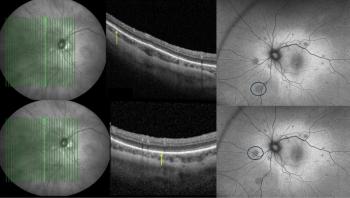
AMD: Then and now
Age-related macular degeneration (AMD) is the worldwide leading cause of blindness. The severe form, choroidal neovascularisation (CNV), faces revolutionary times as new treatment modalities are introduced. Whereas one decade ago argon laser coagulation represented the standard treatment method, nowadays different treatments come into our clinical setting: classic CNV responds well to photodynamic therapy (PDT) with "off label" triamcinolone, and now occult CNV can be successfully treated with an array of treatment modalities: PDT, transpupillary thermotherapy (TTT), subretinal surgery, macular translocation, or anti-angiogenic therapy.
Age-related macular degeneration (AMD) is the worldwide leading cause of blindness. The severe form, choroidal neovascularisation (CNV), faces revolutionary times as new treatment modalities are introduced. Whereas one decade ago argon laser coagulation represented the standard treatment method, nowadays different treatments come into our clinical setting: classic CNV responds well to photodynamic therapy (PDT) with "off label" triamcinolone, and now occult CNV can be successfully treated with an array of treatment modalities: PDT, transpupillary thermotherapy (TTT), subretinal surgery, macular translocation, or anti-angiogenic therapy. The choice often depends on personal preference, surgical ability and environmental circumstances. Firstly, increased age and reduced health status of the patient may exclude them from surgery. Secondly, first eyes that suffer from wet AMD may benefit from subretinal surgery, while second eyes are good candidates for macular translocation. Finally, the initial visual acuity (VA), the type of lesion and coverage by medical insurance often limit the use and success of PDT. In this report we provide a brief overview of the current treatments for CNV in AMD, paying particular attention to the advantages and disadvantages of each.
The surgical approach
There are three types of approach that are currently recommended for the surgical intervention of CNV: submacular surgery, RPE transplantation and macular translocation.
Newsletter
Get the essential updates shaping the future of pharma manufacturing and compliance—subscribe today to Pharmaceutical Technology and never miss a breakthrough.













































